Have you ever wondered what separates a triumphant hunter from a frustrated shooter during small-game hunting? Is it their innate skill, luck, or something more? Let’s say you’re out in the wild, and suddenly, a swift rabbit darts into view, and you have all the time in the world to aim accurately. In that critical moment, the answer becomes crystal clear – the kind of equipment you wield will make or mar your shot.
But of all the tools at your disposal, there’s one that stands out as the ultimate game-changer. Can you guess what it is? The answer lies in a vital tool that can reshape your narrative entirely: the hunting scope. It’s not just a tool; it’s a bridge between you and your target, a gateway to a world where precision reigns supreme.
Welcome to the realm of small game hunting, where every shot counts, and the right scope choice can mean the difference between a tale of conquest and one of missed chances. As we step into this world, we uncover the secrets behind selecting scopes for small game hunting – so you can turn moments of opportunity into triumphant stories.
- Overview of small game hunting
- Types of Scopes for Small Game Hunting
- Factors to Consider When Choosing Scopes for Small Game Hunting
- FAQs
- What magnification range is recommended for small game hunting?
- Can I use a rifle scope for small game hunting?
- What is the ideal objective lens size for small game hunting?
- Are illuminated reticles necessary for small game hunting?
- How does lens coating affect the performance of a hunting scope?
- Can I use a waterproof scope for small game hunting in wet conditions?
- Is a lightweight scope preferable for small game hunting?
- What price range should I expect for a reliable small game hunting scope?
- Are there any specific brands known for producing high-quality small game hunting scopes?
- What are the advantages of using a small game hunting scope over iron sights?
Overview of small game hunting
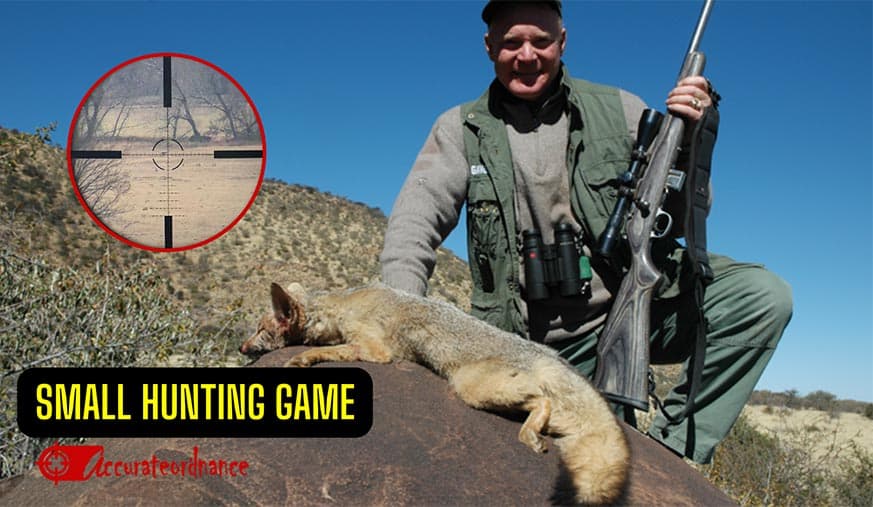
Small game hunting is a time-honored outdoor pursuit that involves targeting smaller animals, such as rabbits, squirrels, upland birds, and various other creatures. Unlike big game hunting, which focuses on larger animals like elk, bears, or deer hunting, small game hunting offers a unique set of challenges and rewards.
One of the defining characteristics of small game hunting is its accessibility. Often requiring less specialized gear and permits, it serves as an entry point for many individuals into the world of hunting. This accessibility, combined with the variety of habitats small game inhabit, makes it a popular choice for beginners and experienced hunters alike.
Small game hunting demands a blend of skills. Patience, keen observation, and stealth are essential, as many small game species possess heightened senses and can quickly vanish into their surroundings. Additionally, accuracy plays a pivotal role, as smaller animals present smaller target areas.
Hunting small game also allows for a diversity of methods. Depending on the species and terrain, hunters might engage in spot-and-stalk tactics, employ hunting dogs for tracking and flushing, or set up blinds and decoys to attract their quarry. Beyond its recreational aspect, small game hunting contributes to wildlife management and conservation. By regulating the populations of various species, hunters play a role in maintaining ecosystem balance.
Types of Scopes for Small Game Hunting
There are different types of scopes that can be used for taking down small game animals, ranging from regular scopes (fixed and variable), Red Dot Sights, Holographic and others. Let’s go into details.
Fixed vs. Variable Riflescopes
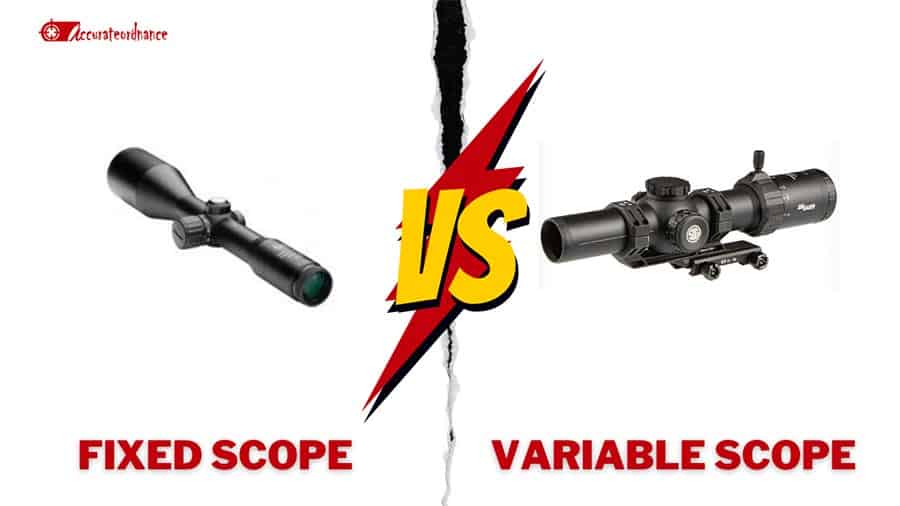
When it comes to selecting a scope for small game animals, one of the earliest decisions you’ll face is whether to go with a fixed magnification scope or a variable magnification scope. Each type has its own set of advantages and considerations, catering to different hunting styles and environments.
Fixed Scopes Pros
Fixed magnification scopes hold a unique appeal for many small game hunters, particularly those who value simplicity in their equipment. These scopes maintain a constant level of magnification, offering a no-nonsense approach to aiming at your quarry. Here’s a more detailed exploration of how fixed scopes relate to small game hunting:
Durability: Small game hunting often involves moving through dense undergrowth, traversing rough terrain, and enduring variable weather conditions. Fixed scopes, with their reduced number of moving parts, tend to be more durable and resilient. They can withstand the bumps, jolts, and impacts that can occur during active hunting sessions.
Simplicity: The fast-paced nature of small games makes it necessary to have a scope with quick target acquisition. With a fixed scope, you can eliminate the need to adjust magnification levels on the fly. This simplicity translates to faster aiming and more accurate shots, as you can focus on your target without distraction or considering whether to increase or decrease the magnification level.
Affordability: Many small game hunters appreciate the value-driven aspect of fixed magnification scopes. These scopes typically come at a lower price point compared to their variable magnification counterparts. For those entering the world of hunting or seeking a reliable scope without breaking the bank, fixed scopes offer an accessible option.
Lightweight Advantage: Hunting small games often involves long treks on foot, making every ounce count. Fixed scopes are generally lighter due to their simpler internal mechanisms. This weight advantage can significantly reduce the fatigue experienced during extended hunting trips.
Fixed Scopes Cons
Limited Versatility: While small games may be encountered at varying distances, fixed scopes restrict your ability to zoom in for longer shots or zoom out for a wider field of view. This limitation can be challenging when hunting species that have the tendency to stay hidden or flee quickly.
Adaptability Challenges: Small game hunting can take you through different terrains, from dense forests to open fields. The lack of adjustable magnification in fixed scopes means you might find yourself ill-equipped for scenarios that demand different levels of magnification for effective targeting.
Fixed scopes excel in straightforward, close-range hunts where quick aiming is paramount. However, if your hunting grounds vary in terms of terrain and distances, a variable magnification scope might better suit your needs. Let’s look at variable scopes.
Variable Scopes: Pros
Variable magnification scopes—often referred to as zoom scopes— offer a dynamic range of magnification levels, providing a versatile solution tailored to the nuances of small game animals. Here’s how variable magnification scopes align with the demands of small-game pursuits:
Versatility: Small game hunting usually involves diverse terrains and variable distances. Variable scopes shine in this context, allowing you to seamlessly transition between magnification levels. Whether you’re stalking rabbits through open fields or tracking birds in dense woodlands, you can adjust the scope to match the circumstances.
Precise Shots: Precision is paramount when hunting small games, especially as these creatures often present smaller target areas. The ability to zoom in with variable scopes empowers you to make accurate shots, even at extended ranges. This precision becomes a game-changer when pursuing an elusive game that demands skillful marksmanship.
Changing Conditions: The landscape and weather can shift unexpectedly during a hunting trip. Variable scopes cater to these changes, enabling you to swiftly adapt to evolving hunting conditions. Whether your quarry moves from a distance to a close encounter or the lighting conditions fluctuate, the adjustable magnification proves indispensable.
Scouting Advantage: Small games require astute observation and quick target acquisition. Zooming out on a variable scope provides a wider field of view, aiding in scouting for potential game or identifying movement in the surroundings. This capability enhances your overall situational awareness, increasing your chances of success.
Variable Scopes: Cons
Complexity: Variable scopes introduce a degree of complexity due to the adjustments required for magnification changes. This complexity can lead to a learning curve, particularly for novice hunters. Fine-tuning magnification levels under pressure may demand practice and familiarity.
Cost Considerations: The advanced features and mechanisms of variable scopes often result in a higher price tag compared to fixed magnification options. However, the investment can be justified by the enhanced versatility and performance offered by these scopes.
Weight Factor: The internal mechanisms of variable scopes may add some weight to your firearm. While the difference may not be substantial, it’s worth considering if you prioritize a lightweight setup for ease of carrying during long hunting trips.
Red Dot and Holographic Sights for Small Game Hunting
Red Dot Sights
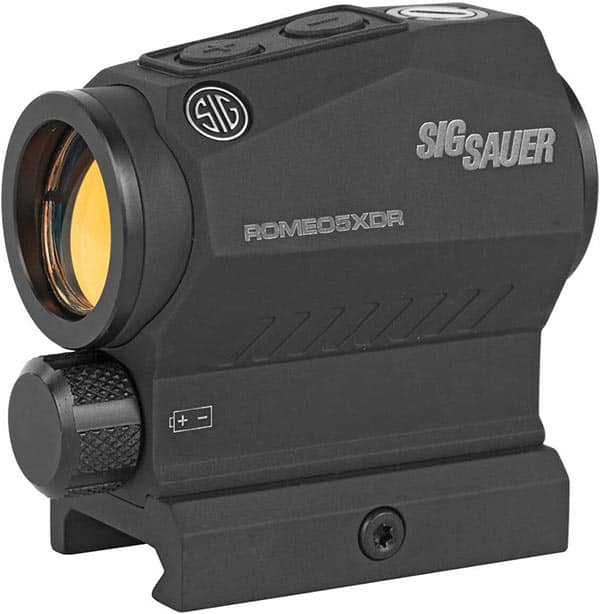
Red dot sights have emerged as favored companions in this pursuit, revolutionizing the art of targeting. Their unique attributes align seamlessly with the challenges of small game hunting:
Close-Range Engagement: Small game are characterized by quick movements and elusive nature and often presents themselves at close to moderate distances. Red dot sights shine in these situations, enabling hunters to acquire their targets in a split second without the distractions of complex reticles.
Fast-Moving Targets: Rabbits darting through underbrush and squirrels leaping among branches demand not only precision but also swiftness in aiming. The rapid target acquisition of red dot sights ensures that you’re always on point, allowing for reactive and accurate shots on these agile game animals. Just ensure that your red dot is accurately zeroed.
Unobstructed Field of View: In the thick of a hunt, being aware of your surroundings is as crucial as targeting your game. Red dot sights provide a clear field of view uncluttered by crosshairs. This clarity proves invaluable when tracking movements, spotting additional game, or simply staying alert in dynamic hunting environments.
Holographic Sights and Their Advantages
Small game hunters who seek an extra edge in accuracy and targeting finesse often turn to holographic sights. These advanced optics elevate the hunting experience by projecting a 3D reticle onto the lens.
Enhanced Accuracy: Holographic sights offer a reticle placement that is consistently accurate, allowing for confident shots even in challenging scenarios or unconventional shooting positions.
Parallax-Free Design: In dynamic hunting scenarios, maintaining your focus on the target can be a challenge. Holographic sights mitigate this by being parallax-free, ensuring that your reticle remains on target regardless of your eye position. This feature proves vital when swift adjustments are required in the heat of the hunt.
Factors to Consider When Choosing Scopes for Small Game Hunting
Different Types of Small Game Animals
Small game hunting encompasses a diverse range of animals, each with distinct characteristics and behaviors. Understanding the specific species you intend to pursue is a fundamental step in selecting an appropriate scope:
Rabbits and Hares: These fast-moving creatures are known for their agility and tendency to bolt suddenly. A scope with fast target acquisition, such as a red dot sight, can prove invaluable in tracking these elusive game animals.
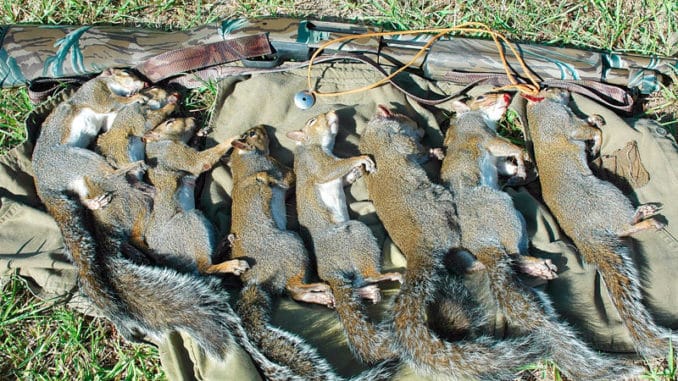
Squirrels: Squirrels often inhabit tree canopies and require accurate shots even in cramped spaces. A scope with clear optics and possibly a variable magnification feature can aid in precise targeting amid challenging angles. Check out the Best Scope for 22LR Squirrel Hunting.
Upland Birds: Hunting birds like pheasants or quails involves quick reflexes and the ability to identify targets against various backgrounds. A scope with a wide field of view and reticle that doesn’t obstruct your sight picture can be advantageous.
Small Predators: Pursuing small predators like foxes or raccoons requires precision and versatility. A variable magnification scope can help you adapt to varying distances, while a reticle with range-compensating marks (BDC) might assist in making accurate shots.
Hunting Challenges and Requirements
The choice of your scope should align with the specific challenges posed by your chosen game and hunting environment:
Terrain and Range: Consider the landscape you’ll be navigating. Will you be hunting in dense woodlands, open fields, or a combination of both? Your scope choice should cater to the distances at which you’re likely to engage your game.
Target Behavior: Understanding the behavior of your chosen small game is crucial. Some species are more likely to remain stationary, while others might flee at the slightest movement.
Light Conditions: Small games are often available during the early morning or late evening when light conditions can be less than ideal. Opt for a scope with good light transmission and low-light performance to maintain visibility in dim environments.
Firearm and Ammunition: The caliber and type of firearm you’re using will influence your scope choice. Smaller calibers like .22 LR have specific requirements for accuracy and trajectory, which can be matched with appropriate scopes.
Hunting Environment
Woodlands: In dense forests, visibility can be limited, and shots are often taken at closer ranges. A scope with a wide field of view and good light transmission is essential. Consider a scope with lower magnification settings to maintain situational awareness and quick target acquisition.
Fields: Open fields offer greater visibility, but shots can be taken at varying distances. A scope with a higher magnification range is beneficial for spotting small game from a distance and accurately engaging them. Consider a variable magnification scope for adaptability.
Marshes and Wetlands: These environments can present challenges due to water reflections and uneven terrain. A scope with anti-glare coatings and waterproof construction is important to maintain clear visibility. A reticle with elevation compensation can also aid in targeting uneven ground.
Magnification
Low Magnification: A scope with lower magnification (e.g., 1-4x or 2-7x) is ideal for short-range hunting scenarios, such as thick woodlands or areas with frequent close encounters. It allows for quick target acquisition, maintains situational awareness, and is less prone to image shake.
Medium Magnification: Scopes with medium magnification (e.g., 3-9x or 4-12x) strike a balance between close-range and longer-range shooting. They provide versatility for a variety of hunting environments and allow for accurate targeting at moderate distances.
Quality of Optics
The quality of optics significantly impacts your ability to spot and accurately target small game. Clear and crisp imaging enhances your overall hunting experience:
Lens Coatings: Look for scopes with multi-coated or fully multi-coated lenses. These coatings reduce glare, enhance light transmission, and improve image clarity in various lighting conditions. Anti-reflective coatings also help minimize unwanted reflections.
Objective Lens Diameter: A larger objective lens diameter allows more light to enter the scope, improving image brightness and clarity. However, consider that larger objective lenses can add weight to the scope, affecting portability.
Exit Pupil: The exit pupil is the diameter of the beam of light exiting the eyepiece. A larger exit pupil (calculated by dividing the objective lens diameter by the magnification) provides a brighter image, which can be particularly beneficial in low-light conditions.
Eye Relief: Small game hunting often involves quick aiming and shooting from various positions. A scope with generous eye relief ensures that you maintain a comfortable distance from the eyepiece, even during recoil, preventing scope-related injuries.
Reticle Clarity: The reticle should be clear and easy to read. Complex reticles can be distracting during fast-paced hunting, so consider simpler designs for quick and instinctive targeting.
FAQs
What magnification range is recommended for small game hunting?
The recommended magnification range for a small game depends on your shooting distances. For close to moderate ranges, a scope with lower magnification like 1-4x or 2-7x is great. If you expect longer shots, consider scopes with 3-9x or 4-12x.
Can I use a rifle scope for small game hunting?
Yes, you can use a riflescope for small game hunting. Just make sure to choose one that suits the hunting conditions and the distances you’ll be shooting.
What is the ideal objective lens size for small game hunting?
The ideal size for the front lens (objective lens) depends on the light conditions. Around 40mm to 50mm is generally good for small game hunting because it helps gather more light, especially during early morning or late evening hunts.
Are illuminated reticles necessary for small game hunting?
Illuminated reticles aren’t necessary, but they can be helpful in low-light situations. They make your aiming point stand out, making it easier to target small game animals.
How does lens coating affect the performance of a hunting scope?
Lens coatings help reduce glare and improve how much light reaches your eye. Scopes with good coatings have clearer images, especially in bright sunlight or dim lighting.
Can I use a waterproof scope for small game hunting in wet conditions?
Yes, using a waterproof scope is a good idea for hunting in wet or rainy conditions. It prevents water from getting inside the scope and damaging the optics.
Is a lightweight scope preferable for small game hunting?
Yes, a lightweight scope can be easier to carry during long hunts, but balance is important. You want a scope that’s light enough for convenience but still rugged enough to handle the outdoors.
What price range should I expect for a reliable small game hunting scope?
Reliable small game hunting scopes can range from around $100 to $1000 or more. Finding one that fits your budget and offers the features you need is a good idea.
Are there any specific brands known for producing high-quality small game hunting scopes?
Yes, there are reputable brands like Vortex, Leupold, Nikon, and Bushnell that are known for producing high-quality scopes suitable for small game hunting.
What are the advantages of using a small game hunting scope over iron sights?
Using a scope makes it easier to see your target clearly, especially at longer distances. Scopes also offer features like adjustable magnification and reticles, which can help improve accuracy and make aiming quicker and more precise compared to iron sights. Iron sights are better for man-size targets or larger animals at close to medium range.
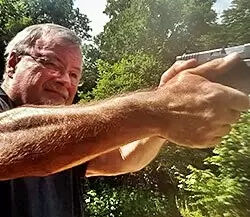
Mike Hardesty is a published freelance gun writer. He also possesses specialized expertise in rifle scopes With dozens of articles and reviews published in Pew Pew Tactical, Snipercountry.com, and TTAG (The Truth About Guns), Mike is considered a firearms expert. His special area of expertise is handguns.
Mike is a long-time shooter. He has been punching paper targets, taking deer and other game and shooting at competitions since about 1975. Other related pursuits include reloading and bullet casting. He currently reloads for over 10 calibers, both handgun and rifle. His reloads, particularly for 9mm, were in great demand during the height of the ammo shortage among family and friends. He donated hundreds of rounds to informal shooting sessions. He was quoted as saying “I do not sell my reloads but I sure will help my guys shoot ’em for free!”. He has a few cherished firearms that he has inherited or otherwise procured — those are his favorites.
He earned B.S. and M.S. degrees from Indiana State University in 1974-1975.
He’s a firearm experts and is the founder of mhardesty.com.
